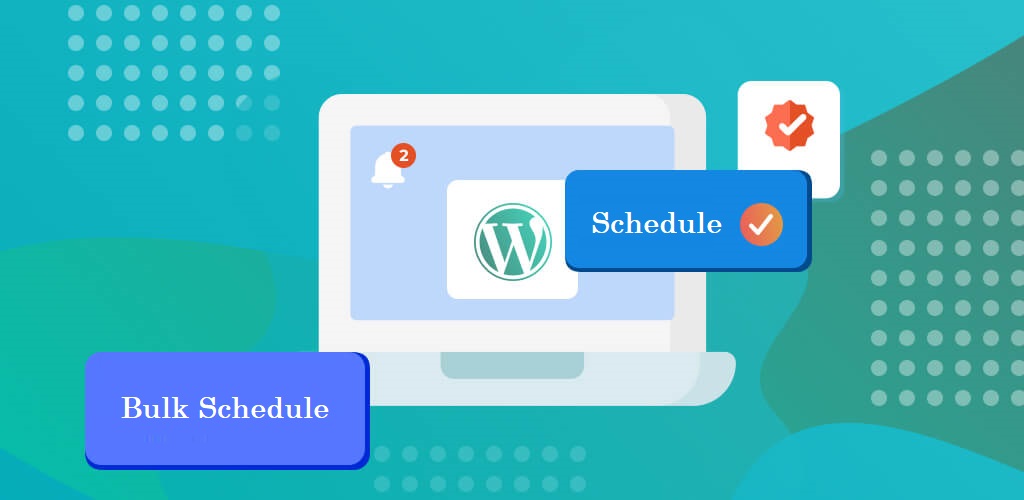
Recently, a lot of WordPress users as been looking for means to schedule posts automatically published in WordPress in batches. Positioning posts in WordPress is actually unpretentious, but what if quick planed numerous drafts are needed at once?
When you have several articles waiting to be published, batch scheduling comes in handy. This article will show how to easily bulk schedule posts in WordPress.
When is the schedule of WordPress posts in bulk needed?
For single-author who creates and manages the content on the blog, it is easy to schedule blog posts using the default publishing schedule feature in WordPress. But if editing and arranging a large number of posts from multiple authors is needed, then it may take some time.
The native WordPress plan feature requires you to open each post individually to arrange and then save. Although the bulk plan option allows you to schedule multiple posts at once, this will save time spent increasing traffic and growing your blog. With this, let’s take a look at how to easily schedule posts in batches in WordPress gradually.
WordPress Bulk Schedule Posts
The first thing for Bulk Scheduling of posts in WordPress is to install and activate the Auto Post Scheduler plugin. Subsequently, activation, visit Settings »Automatic Release Plan page to put up an instinctive set plan.
Automatic release scheduler settings in WordPress

At the top, the status of the automatic release scheduler is disabled by default and the “Enable automatic release scheduler” button. By clicking the “Enable Auto Post Scheduler” call-to-action button, the default plugin settings are enabled.
This is why it is recommended to review and updating plugin options before enabling the scheduler. First, set the interval for automatic publishing. By default, it is put to 24 hours, which propose drafts will be automatically published within a 24-hour interval.

If publishing an article everyday id preferred, leave it unchanged. If publishing two articles daily is what is needed, set it to 12 hours.
Automatic release scheduler interval options
Next, there is a “Restart Publish” option. select this option if making the plugin to republish the published post is the goal. This setting basically allows for recycling old content and make the blog look fresh.
After that, the “Start Schedule Delay” option allows setting a time delay before the first scheduled post goes online. By default, it is set to 0 seconds, which means that the first scheduled post will be published immediately after the scheduler is enabled.
Delay option after the automatic release of the scheduler

Next, “Limit checking these post types” allows choosing the types of posts needed to be scheduled automatically. By default, “Publish” is selected. If need arise to also enable automatic scheduling for the pages, it can be added to the selection by holding down the Shift key on the keyboard and clicking them.
Choose the type of post to schedule

Similarly, there is an option to select the categories to be included in the automatic plan. All categories are added by default. However, it most cases people exclude the “Uncategorized” category. To do this, select other categories by pressing the Shift key on the keyboard and clicking other categories.
Choose a category to arrange WordPress posts

After that, notice the option to “Limit checking of these authors’ posts.” include everything or exclude anything by choosing what to include. All authors are included by default.
Choose an author to schedule a post in WordPress

keyword search restrictions that can also be used to check posts. If the need arises to exclude posts containing specific keywords, add these keywords before the hyphen and enter them in the field. Another useful feature is “Limit Checks on Specific Dates”, which allows users to set the time of posting a post. Enter the time range in 24-hour format.
For example, if the user wants to post on Monday from 9 am to 9 pm, he needs to enter 0900-2100 in the field on Monday.
Restrict checking on specific dates to schedule posts

If these arenas are left absolute, all times of the day will be made use of. After that, choose the date when the post will not be scheduled.
Select eligible posts to arrange for Bulk Schedule

Next, choose the post status that meets the criteria. Preferably a draft status, pending status, or a published post. Below more settings to recycle or repost old posts can be used. They are very useful if the user needs to update old posts with new release dates. After reviewing all the settings, click the “Update Options” button at the bottom.
Update automatic release scheduler options

Now after updating the scheduling options, go to the top and click the “Enable automatic publishing scheduler” button.
Enable automatic release scheduler in WordPress

that’s it! The plugin will automatically arrange all eligible posts for future use. No need to manually open the post for planning. However, automatic scheduling sometimes reduces the speed of high-traffic websites because it uses WordPress WP-Cron for scheduling. Solve this problem by setting up a Cron check on the schedule or using the WordPress cache plugin.





